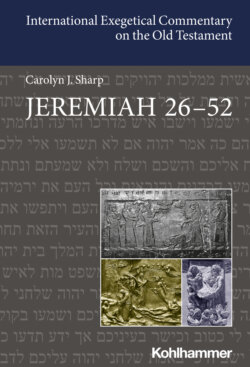Читать книгу Jeremiah 26-52 - Carolyn Sharp - Страница 17
На сайте Литреса книга снята с продажи.
A Community Divided
ОглавлениеFierce political divisions Years of intense cultural anxiety and the trauma of the forced deportations in 597, the Babylonian siege and ransacking of Jerusalem in 587, and further deportations all served to inflame political tensions among those who had survived. Scribes responsible for preserving and shaping the heritage of the prophet Jeremiah argued bitterly about how to understand what had happened to Judean political structures, to the Judean community, and to the religious heritage of the covenant people. As Robert Carroll puts it, “The book of Jeremiah appears to have become the resting place for a number of quite discrete and often disparate ancient social and ideological controversies.”73 Dalit Rom-Shiloni traces the trajectory of opposition between the Babylonian exiles and those in Judah to Ezekiel as the architect of division. Rom-Shiloni writes,
Active as a prophet in the Exile, Ezekiel not only collected the “broken pieces” of that catastrophe, but with great aptitude he laid the foundations for the Babylonian community’s self-perception as the only people of God. In so doing he formulated the “takeover” strategy of this Diasporan community by which it became the core community of “Judah” within just a few decades. Exilic authors, prophets and historiographers carried on and developed further Ezekiel’s oppositions between the (Jehoiachin) exiles and the people who remained in Jerusalem.74
We can see the same oppositional dynamics in the Dtr-Jer prose, as Karl-Friedrich Pohlmann, the present author, and others have noted.75 These antagonisms are discernible as well as in later texts such as Ezra–Nehemiah. Mark Leuchter argues that social and theological tensions between Deuteronomist and Zadokite scribal groups are perceptible in Ezekiel’s reworking of motifs from the Jeremiah traditions. The way in which Leuchter characterizes the lively and perhaps polemical relationships among those scribes is helpful for imagining also the arguments internal to the layered and complex book of Jeremiah: we see “a sort of pre-Rabbinic responsa literature emerging among the various intellectual and religious elites of the exilic community, with each group acutely aware of the views and arguments of their opposition.”76 Indeed, and the crafting of arguments and counter-arguments in the Jeremiah traditions continued far into the postexilic period.
Authentic and illicit prophecy Important for the apprehension of prophecy as represented in JerMT is the conflict between true and false prophecy—prophecy subsequently verified or disconfirmed—in times of political crisis and ways in which constituent groups heed or resist the warnings of Jeremiah, the authoritiative prophetic voice. Scribes, officials, priests, prophets, residents of Anathoth, Judeans in diaspora in Babylon and Egypt, Judeans left in the land after the fall of Jerusalem, and all the people, construed sometimes in the broadest possible way as “the whole house of Israel and the whole house of Judah” (13:11): all these groups have their roles to play as regards the authentic and illicit prophecy depicted in the prose narratives and poetry of Jeremiah. In this artfully shaped set of traditions, which are depicted as spoken word and as written scroll subsequently rewritten and amplified (Jer 36), these groups also bear political valences that are carried forward, culturally speaking, beyond the present moment of any particular oracle or incident within the plot. They signal alliances and attitudes of malfeasance with strong implications for the political conflicts of the exilic and postexilic periods. This is clear from harshly polemical texts such as Jer 24 and 42–44, and no less true of more subtle texts in Jeremiah.
Valorized characters In connection with the portrayal of constituent groups, we may remark a noteworthy feature of the Jeremiah prose: literary focalization on characters within the plot to further metanarratological goals. Literary focalizing promotes the approval of allies through lionization of heroes and critique of opponents through virulent attacks on adversaries. Heroes—valorized individuals who represent supportive reception of the prophet Jeremiah—are Ahikam son of Shapan (26:24), Baruch the scribe (Jer 36), and Ebed-melech the Ethiopian eunuch (38:7–13). Other individuals come in for critique, directly or through subtle narrative means. These include the priest Pashhur (20:1–6); false prophets Hananiah (28:1–17), Ahab and Zedekiah (29:21–23), and Shemaiah son of Nehelam (29:24–32); and the rulers Jehoiakim and Zedekiah. Throughout the dramatic narratives of the Dtr-Jer prose, the implied audience witnesses Jeremiah surviving threats against his life and being aided through the interventions of three iconic heroes, Ahikam, Baruch, and Ebed-melech. Four iconic adversaries seek to injure or constrain Jeremiah’s prophecy: Pashhur, Hananiah, King Jehoiakim, and King Zedekiah. Jeremiah prevails, just as Yhwh had promised when the prophet was originally commissioned decades earlier: “Do not be afraid of them, for I am with you to deliver you” (1:8).
